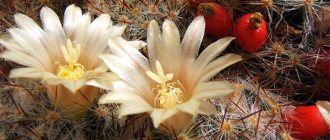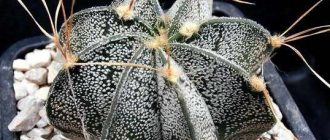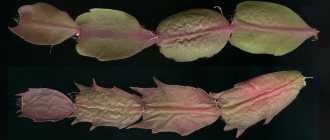Mammillaria is a multifaceted and infinitely diverse cactus, the genus of which represents a separate principality in the cactus kingdom. In the wild, it grows everywhere on both American continents, with the exception of their northernmost and southernmost territories. This is the most frequent guest of home cactus collections, and sometimes their only representative, since the cultivation of its various species represents a separate area of plant collecting. The popularization of mammillaria is also facilitated by its ease of care; this cactus requires minimal attention and forgives many blunders when grown at home. And if you care for it correctly, the reward will be its luxurious, long-lasting and amazingly delicate flowering.
General description with photo
Mammillaria is a succulent from the vast Cactus family, diverse not only in shapes and colors, but also in preferred growing conditions. Some species of this cactus are found primarily in hot deserts, while others prefer cool mountains, sea coasts or dry limestone mounds. However, this does not create additional difficulties when growing mammillaria at home, since its temperature requirements are reduced to ensuring the difference between daily temperatures, characteristic of a dry, sharply continental climate.
A distinctive feature of the genus is the tubercular structure of the body; its stem is strewn with tubercles-papillae (mammillae), called tubercles. Most varieties of mammillaria are small in size; there are also very miniature representatives. The shape of the fleshy stem is usually spherical; with age, it may stretch upward to become ellipsoidal-cylindrical. Flat-oblate varieties and short-cylindrical forms are less common, but they are more in demand in home floriculture. The stem can be single or have numerous branches. Tubercles are modified leaves, at the ends of which there are areoles with a tuft of soft pubescence and/or spines. They can sit very tightly or loosely, in any order. Mammillaria does not have ribs, like many representatives of cacti. The root system is shallow, the roots are fleshy, shortened, tenacious.
Common growing problems
Among crop pests, the red mite is considered the most dangerous. To combat the parasite you will need Actellik. A popular problem when growing crops is the strong stretching of the bush towards the light source, this leads to damage to the crop. Therefore, try to choose comfortable conditions for the culture.
How often the Mammillaria cactus blooms depends primarily on proper care. By following all the recommendations, you will be able to get a spectacular and attractive bush that produces flowers almost continuously.
Mammillaria bloom
Flower buds, as well as lateral stem shoots, begin to develop from the axils of the tubercles. If in their upper part they are almost always equipped with sharp and hard spines, then below there is a rim of short soft fluff or the same soft long hairs entangling the entire stem. On those of them on which a bud begins to form, this pubescence begins to grow, after which a flower quickly develops from the axil. Most often, the inflorescences are not single and are arranged in a circle, bordering the apical part with a flowering ring. The sizes of the inflorescences range from 1-6 cm, while the larger the size of the flower, the fewer of them there will be on one specimen. The color range is wide; in addition to the classic yellow, white and pink-red colors, you can find beige, silver, purple and variegated varieties. The shape of a mammillaria flower can be tubular, bell-shaped or disc-shaped. Flowering of cactus at home usually begins in early spring and lasts about six months, but it can also occur prematurely, in winter.
The buds open fully only in bright light.
After flowering, subject to pollination by insects or wind in nature or artificial fertilization at home, the ovary begins to form in the axillary bud. Within 2-3 months, the fruit ripens, which is a round or club-shaped growth. The fruits can remain on the body of the cactus for up to 10 months, decorating them with their bright appearance, and then the capsule bursts, scattering numerous seeds, which can be red, green or dark brown.
Mammillaria can be found both on the plains and at an altitude of up to 2.5 km above sea level.
General information
A feature of Mammillaria is the presence of characteristic papillae arranged in a spiral. At the top of each papilla there is a spine. The most common types are:
Mammillaria bocasana (Mammillaria bocassa) - has a silvery branching stem. It blooms in spring with small white flowers forming a wreath at the top of the stem.
Mammillaria wildii (Mammillaria Wilda) - very similar to Mammillaria bocassi. The only difference is the ovoid stem
Mammillaria rhodantha (M. red-flowered) and Mammillaria hahniana (M. Ghana) bloom pink flowers.
As well as many other interesting specimens. Some Mammillaria have decorative fruits after flowering, which gives them additional charm.
Types of mammillaria with photos
Due to the large number of varieties of this succulent (more than 200), it is not possible to describe them; in addition, botanists are constantly revising, supplementing and adjusting the classification of the genus. Here are descriptions and photos of the most famous and home-grown mammillaria.
Golden-haired
The origin of the species is the highlands of Mexico. It is a spherical, flattened, single-type stem about 6 cm high. The root system is compact and fleshy. The tubercles are oval-elongated, sparsely located, not dense, and therefore do not touch each other. The stem is devoid of sharp thorns, but is entangled with thin and long hairs of white or golden color. The inflorescences are bell-shaped, medium in size, colored in creamy pink tones with a darker stripe in the center of the petals.
Bokasana
It grows well, forming a group of dense shortened cylindrical stems. It bears long thorns of two types - the first are dark, with hook-shaped ends, the second are white, soft, enveloping the cactus with their fluffy pile. The flowers are two-tone, soft pink, with a darker pink stripe in the center of the petals.
Wilda
It has a dark green stem that produces numerous side shoots that continue to grow on the mother bush without separating from it on their own. The tubercles are not touching, elongated, but not long. The central spine is long, with a hook at the end, the frame is finely threaded, prickly. It blooms often, the buds are white with a yellowish center, they do not bloom together, one at a time, the petals have a pointed shape.
Bokasan mammillaria
The stem at a young age is spherical, gradually lengthening, usually does not exceed 5 cm in diameter. The tubercles are oval in shape, with a central hook-shaped spine and abundant silky-white pubescence. The species tends to grow in large groups. The flowers, depending on the variety, are white or raspberry-pink, with a richer center of the petal and a “plastic” shine.
Zeilman
A brightly and luxuriantly blooming species, producing a dense ring of inflorescences framing the stem like a wreath. The color of the petals is bright pink with a crimson tint, rarely white, the size of the flowers is small, but they open, replacing each other, for six months. The shape of the rich green stem is short-cylindrical.
Runaway
A miniature variety that forms entire colonies due to the rapid growth of lateral shoots. The stems are shaped like small balls covered with hair-like needles. In the center of the tightly seated tubercles they are colored golden-yellow, along the edges - white. Due to the absence of the need for cross-pollination, the plant blooms and bears fruit profusely even at home.
Carmen
Another highly branched species with a dense, elongated oval stem. The pubescence of the areolas is dense, needle-shaped, creamy in color. The flowers are white, quite large, bloom randomly at the apical part, the core is painted pale yellow.
Luti
Miniature, short, pubescent balls without spines, highly decorative.
Zelman
A classic variety with a stem that lengthens as it grows, with tightly fitting lateral shoots. The central spike is red, with a hook at the tip. It blooms very beautifully in pink-purple color with petals shining in the sun. The inflorescences are formed not in a ring, but along the entire upper part of the stem, which is why at the height of flowering the cactus itself is practically invisible. This is an unpretentious variety of mammillaria, easy to care for and suitable for growing at home by beginners in floriculture.
Plumosa or Mammillaria pinnate
One of the most interesting and highly decorative varieties. It has the appearance of felt, bird-feather-like, widely spread spines. As it grows, it forms snow-white felt “pillows” with rare white flowers.
Lighting
Lighting and temperature are directly related for Mammillaria. Too bright sunlight leads to burns on the stems of succulents, as well as to wrinkling and wilting of the plant. Therefore, it is better to place Mammillaria on western and eastern windows, and on southern windows - to protect them from the bright sun.
At the same time, northern windows are absolutely not suitable for a cactus. The plant acquires a light green, sickly color, and the stem becomes elongated. Flowering in such conditions is impossible.
Home care
The mammillaria flower is absolutely undemanding in care, withstands hardships, and is able to remain viable for a long time in conditions of moisture deficiency or even its complete absence. But, of course, it also has certain conditions for comfortable maintenance, and if you care for mammillaria correctly, the result will be more interesting and decorative. First of all, this concerns lighting. This cactus loves to grow in the sun, but on particularly hot days it will have a hard time withstanding the midday rays. Low lighting levels cause the stem to stretch, and in this case there may be no flowering.
Watering
This is the easiest point of care, since it is necessary to moisten the soil for mammillaria that are not in the scorching sun 2-3 times a month, and in winter once will be enough. But it is better to water not according to a schedule, but when the substrate dries out. The earthen lump should dry not only on top, but almost completely. The amount of watering also depends on the season. If in summer the earthen ball needs to be completely moistened, then in winter it is enough to moisten it from above. Some varieties do not require winter watering at all.
Planting several species of mammillaria in one wide container looks very interesting, especially if it is possible to achieve their simultaneous flowering.
Temperature
The main, but not categorical, temperature requirement is to ensure a difference between night and day temperatures. If the cactus is on a windowsill, it will feel great if it is slightly shaded from the sun on a hot summer afternoon. If the desired temperature difference cannot be achieved, nothing terrible will happen, but the conditions will not be so comfortable for the flower, and the flowering will not be so lush.
Rest period
The plant has an unexpressed dormant period, which traditionally occurs in winter. How to care for mammillaria at this time? The best thing to do is leave her alone. Rarely wetting the soil surface will help the plant not to die, but it is not necessary for all varieties. But the cactus needs to be kept cool. At home, if you have central heating, it is sometimes difficult to find such a place; in this case, you can leave the cactus on the windowsill, placing it closer to the glass, but provided there are no blown cracks. However, not all mammillaria can easily tolerate temperatures down to +10C. Hairy species, as a rule, are more thermophilic; for some of them the lower temperature limit is +15C. As for the summer heat, the cactus tolerates it without any problems.
A period of rest is necessary for mammillaria to continue its life and ensure flowering.
Air humidity
The flower treats dry air absolutely calmly. There is no need to apply any additional measures to increase its humidity. If for some reason spraying is carried out (for example, to knock down dust and refresh the plant), then this should be done in the early morning hours and only with very small drops of water.
Top dressing
Caring for mammillaria at home involves the moderate use of fertilizers; monthly application of mineral compounds for cacti and succulents is sufficient, and only in the warm season. If there are no specialized formulations, you should select a complex with a predominant content of potassium and phosphorus. The nitrogen component should be absent or insignificant, because it inhibits the development of this crop and makes the stems of cacti soft and watery.
Temperature
All cacti are thermophilic and Mammillaria is no exception. However, it prefers moderately warm temperatures. The temperature range is 21-260C in summer, and not lower than 160C in winter.
In winter, Mammillaria must be provided with peace, and only under this condition will it be possible to admire the flowering of this crop in the spring.
How to properly transplant mammillaria after purchase?
This cactus is tolerant of transplantation, so after purchasing a ready-made specimen, you can transplant it from a temporary sales container into a permanent pot in 1-2 weeks. It is better to do this by transshipment with the addition of the required amount of specialized substrate for succulents. The presence of a coarse-grained drainage layer is mandatory!
It is better to moisten the soil with a spray bottle in advance than to water an already transplanted cactus.
Planned mammillaria transplant
The cactus itself grows slowly, but can produce an extensive increase in children. If they feel cramped in a pot, they are seated in different containers or in one, but wider one. During transplantation, the children are separated with a knife, followed by drying the cut. There is no need to bury them when planting; just screw them lightly into the ground. To ensure stability, young seedlings are surrounded with stones.
Transfer
How is a mammillaria cactus transplanted? The procedures are performed every year. And adult plants need 1 transplant every 2-3 years. It is advisable to replant in the spring, when with warming the cacti wake up and more easily get used to the new place.
You can choose a plastic or ceramic pot. The container should not be deep; it is important to choose wide dishes. A drainage layer, for example expanded clay, is placed on the bottom, and then a soil mixture. It is important that the soil is porous and permeable. The soil is excellent for cacti; it consists of sand, leaf, and turf soil. The components must be taken in a ratio of 1:2:2. Brick chips are also added. Cactus soil may include charcoal, shell rock or limestone.
Reproduction
Mammillaria can be planted by seeds, but most often there is no such need, since the crop reproduces well by lateral shoots. The vegetative path is simpler, faster and guarantees the preservation of parental characteristics. The separated shoot should lie in the air for 5-7 days so that the wound heals after it is separated from the donor plant.
But, despite the simplicity of the vegetative propagation method, this process cannot last indefinitely due to the gradual degeneration of the family. To restore the decorative quality of the crop, you will have to resort to seed cultivation from time to time, using purchased selective planting material.
Diseases and pests
The most common pests are red spider mites and mealybugs. These pests are almost impossible to remove from the cactus, given its special structure.
The multiple hairiness of the succulent negates all the efforts of the gardeners and Mammillaria dies. Therefore, if you have such pests in your collection, the source of infection will have to be thrown out or quarantined for treatment with insecticides so as not to infect other plants.
But quarantine is often useless! Nematodes are no less terrible for Mammillaria.
Mammillaria diseases occur when agricultural practices for growing a given crop are violated. Powdery mildew and rot are the results of waterlogging and hypothermia of the plant.
When does a cactus bloom?
Mammillaria begins to produce its beautiful flowers with the arrival of spring and allows you to enjoy them until autumn. When growing at home, cactus can bloom in winter, the main thing is to provide it with good lighting. The cactus needs to be grown in conditions where it can receive light for 16 hours or more. Fluorescent lamps can serve as a good assistant. Flowering duration is about six months.
During flowering, the main part of mammillaria varieties forms a crown of flowers on the central stem at the top. The range of colors and shades is quite extensive. Petals can be white, red, scarlet, crimson, beige, cream, and pale yellow. Some specimens have large flowers with a diameter of 3 centimeters, but then there will be no more than 3 flowers on one plant.
Similar plants
Mammillaria mix is a very diverse type of cacti and, when choosing varieties for planting a mix, you can confuse it with the following species:
- Coryphantas;
- neoporteria;
- rebutia;
- turbinicarpus;
- Echinocactus.
These plants have differences in physiology, care requirements and growing conditions.
When planting a mix, you need to know or consult whether the cacti you have chosen belong to the same species and about their compatibility.
Mammillaria mix is an excellent choice to learn a new hobby and fall in love with cacti. When creating a mix, you can select plants with flowers of different types and colors. And with proper care, they will create a wonderful composition that will be a real decoration for your home.
Content Features
Mammillaria mix is different varieties of this type of cactus growing in the same pot. When grown together, problems may arise due to the structural features of the plants or the conditions of detention. Due to different requirements for light, humidity or temperature, some plants may stretch, others may die, which is why it is necessary to select cactus varieties with similar growing conditions for planting together.
Abundantly branching mammillariae will eventually grow in width and interfere with each other. Varieties with long spines can also interfere with neighboring plants; as the cacti grow, they will damage the specimens growing nearby. Therefore, in the mix you need to plant varieties of few branching cacti with short needles , similar sizes and trunk shape, for example, Mammillaria Carmen, Excellent (perbella), Duwe (duwei) will get along well in one pot.
There are other types of mammillaria, read about the exotic prolifera, the beautiful elongated, unpretentious bokasana.
Using mimmillaria:
Mimmillaria is actively grown in houses, apartments, gardens and, of course, is an integral part of greenhouses. Using it you can create unusual and exquisite phytocompositions. This type of cactus should be grown in wide and shallow containers, because even one such plant will soon grow and fill all the free space.
Regardless of the chosen type, you can get a beautiful, prickly and even airy “cushion”. For example, by planting Mammillaria runnerum, you can get an amazingly beautiful ornamental plant that will not only delight with the beauty and brightness of its flowers, but also be covered with fruits that look like bright beads on it.
Priming
Many gardeners prefer not to bother with preparing the soil once again, but immediately buy a ready-made soil mixture for cacti.
If you still decide to prepare the soil yourself, then you will need to mix three different types of soil, coarse sand from the river and brick crumbs.











